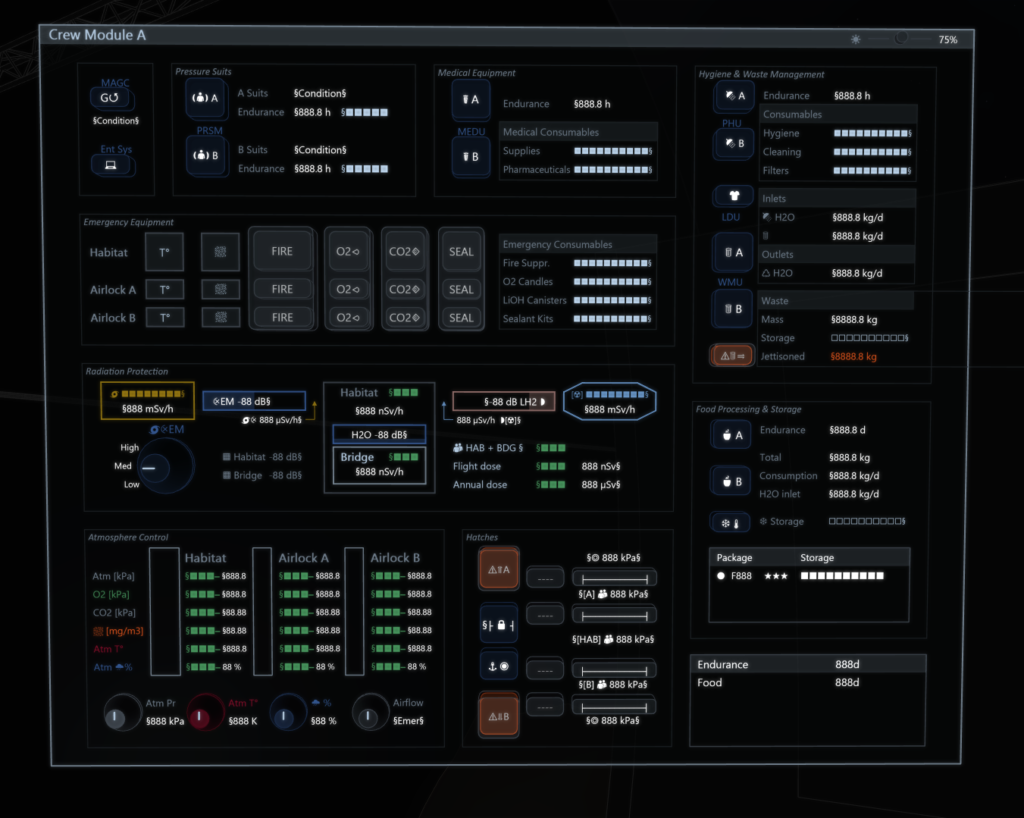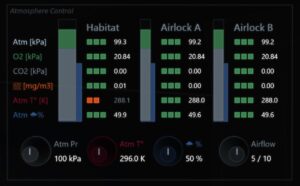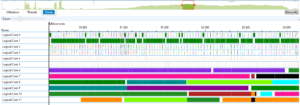No video for this quarterly 2023-Q1 update as the coding is ongoing!👨🔧 So instead here’s an overview of the ship’s life support systems being implemented, as seen through their main interface panels in the engineering station.
The CSN-F9 frigate features a crew of 4, with accommodations for a few passengers. However deep space is a very hostile environment for biological beings, especially as travel times can exceed several weeks. The role of the ship’s front section is thus to provide a safe environment for the pilots.
The gameplay objective here is to represent this essential aspect of space flight consistently with the game’s chosen hard sci-fi technology and level of systems detail. Most modeled systems are actually inspired by real-life implementations.

Below are the main features (work in progress):
- Module Space
The front section will consist in a main habitat enclosing two access airlocks and the bridge from which the ship is actually commanded. - Crew
The ship’s personnel will be represented by a single entity with various characteristics and abilities (more detail about the related gameplay in a coming update). It will feature a metabolism model in interaction with the module’s environment. - Atmosphere
The model will include the total air pressure, the partial pressures of nitrogen, oxygen, carbon dioxide, water vapor (relative humidity), the concentration of contaminants, and air temperature. - Radiation Protection
The modeled ionizing radiations will include both cosmic particles and residual neutrons from the reactor. A set of shielding devices will ensure that the received dose remains within safe levels:- an array of superconducting coils surrounding the module will generate the strong magnetic field necessary to deflect high energy cosmic ions (“EMS” for electromagnetic radiation shield),
- while most of the fusion’s D-D and D-T neutrons will be captured in the reactor itself, the main LH2 tanks will further protect the front section from the residual flow,
- the habitat structure will provide additional passive shielding (hydrogen and boron enriched meta materials),
- the water tanks surrounding the bridge will enable its use as a “storm shelter” against the incoming radiations of highest intensity.
- Water and Food Processing systems
- Water will be recycled by the waste management and atmosphere revitalization systems, and produced by the APUs’ fuel cells if need be. It will be stored in two pressurized tanks with a combined capacity of 600 l.
- The ship’s galleys will generate edible food from nutrient packages of various sets of flavors and quality. It will be possible to modulate the crew’s diet as required.
- Hygiene and Waste Management
- The effort spent on personal hygiene, the related water allowance and the cleaning of the habitat will be tunable as dictated by the operational circumstances.
- The waste management units will recycle water from all waste inputs and store the residual solid materials in a dedicated storage compartment.
- Medical Equipment
The module will be fitted with two medical pods and a two seat centrifuge for zero-g syndrome mitigation. - Emergency Systems
The two airlocks will host one set of pressure suits each in case of atmosphere loss or contamination. Additional portable devices will be available to deal with emergencies (fire extinguishers, O2 generation candles, CO2 scrubbers, sealant kits).

A second panel regroups the controls for the front section’s support systems and circuits:
- Electrical supplies power the module’s 400 V “Essential Bus” and the connected equipment. These units include large batteries but no generators as the energy is drawn from the ship’s power plant via the main bus. Also the electromagnetic shield (EMS) protecting the crew against cosmic particles can act as a low-capacity SMES if required.
- Thermal control units regulate the module’s structure temperature and provide cold sources for the connected refrigeration and superconducting devices. Their output heat can be dumped either to the power plant or to the front section’s annular radiator.
- Tanks and distribution circuits manage the nitrogen and oxygen needed for the module’s atmosphere, together with hydrogen used in the CO2 scrubbing process. The oxygen and hydrogen should preferably be drawn from the power plant manifolds. They may also be produced from water by electrolysis units.
- The panel also hosts the interfaces for the water storage, recovery and distribution systems, and also the atmosphere pressure and composition control units.
All the primary equipment are doubled (“A” and “B”). Only one side is required for normal operations, and in flight maintenance will be possible for all the parts that are located into the crew module.
The next update will present all these systems in action,
Thanks for reading!



Is your plan to have the habitat module rendered as a ship interior the player can inhabit, or will it only be modelled at a systems level?
“Never say never” but it will remain at the systems level for now. I’m a solo dev and the scope of the sim is already quite large so I need to focus my limited resources 👨🔧🙂
Will radiation alerts from objects like a local solar flare be detected in ship using onboard ship sensors or will an alert be broadcast using the normal flight control radio?
For radiation, will there be Van Allen belts around gas giants?
The data is planned to be collected by the ship’s celestial navigation sensors at the moment. About Van Allen belts there’s already an old model sleeping in the code but which will require some serious reworking! That said the crew module’s magnetic shield is designed for high-energy heavy cosmic ions (Galactic Cosmic Rays) and so local plasmas – albeit denser – should be efficiently deflected.
I am looking forward to trying out the alliance space guard game! Is there going to be an alpha version of the ASG? Thanks! Cheers, Vincent.
Hello Vincent,
Thank you for your interest in ASG! (Just in case: I replied to your contact messages by email so if you did not receive my answers you might want to check your spam folder).
There is still a lot of work to do before the project can reach the “alpha” stage and so that’s not planned right now. Also I tried to explain the development context in this post: Why no Early Access
Hello David!
Looks like you’re doing some amazing work, I’ll be watching out for the release (full or in the form of public alpha, as you see fit). Sounds like this could potentially be one of the best things to happen to VR as well, if you have VR planned. Do you?
Hello Igor,
Thanks for the encouraging words 🙂
The honest answer about VR is that whatever the outcome I’ll consider the question only after the game’s release. The game’s scope is already very large with respect to my dev abilities! 👨🔧
Great pacing David, you are a one man army 🙂
Ah ah thanks! 😊 That new section is avidly gulping lines of code but its slowly getting online. Right now the electrical, thermal and gas supply parts are operational and the atmosphere model should be up soon 👨🔧
This. Looks Great!
🙂
Thanks 🙂 Hopefully I should be able to post a work-in-progress video in the coming days. Currently fighting stability issues on the relative humidity control! 👨🔧